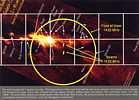from "SETI INSTITUTE Explorer" Second Quarter 2008, Volume 5, Number 2
SETI OBSERVING PROGRAMS ON THE ATA
By Peter Backus
The Allen Telescope Array provides opportunities for more SETI observations over a wider range of frequencies, and with better rejection of interference, than ever before. The ATA is the first telescope designed with SETI in mind from the start. The observing programs are, in turn, designed to take advantage of the ATA.
In the past, most SETI programs "listened" on a limited set of frequency bands, and only within a small piece of each band per observation. Most radio astronomy was done at a few special frequency bands allocated for scientific research. The allocated bands ranged in width from as little as a few megahertz (MHz) to perhaps 100 MHz. (For comparison, an analog TV channel spans 6 MHz.) Every radio observatory developed complex and sensitive receiving equipment for the half dozen frequency bands available to its telescopes.
In the 1990s, the SETI Institute's Project Phoenix expanded the spectral coverage by more than a factor of ten, covering an unprecedented 1,800 MHz. Now, with the advanced technology of the ATA's receivers, we can expand by another factor of five, covering frequencies between 1,000 and 10,000 MHz.
RFI, radio frequency interference, is the biggest challenge facing any SETI program. When looking for signals from light-years away, distracting signals from terrestrial transmitters unavoidably come in loud and clear. With the ability to simultaneously observe multiple spots on the sky, the ATA offer a new technique to recognize and reject terrestrial signals. If a signal shows up at the same frequency at the same time from two or more different spots on the sky, it is really coming in from an entirely different direction, through the "sidelobes" of the telescope. This is the signature of RFI.
Time on large radio telescopes is in high demand. Although it lasted nine years, Project Phoenix only observed about 15% of the time. As a partner in the development of the ATA, Institute projects will now get a large allocation of telescope time. But that's not all. Unlike traditional radio telescopes, the ATA can handle several projects simultaneously. When another radio astronomy project is observing an astronomical object such as a galaxy, we can conduct SETI observations of stars that are within a degree or so of the galaxy's position. With such "commensal" observing, SETI searches should be possible almost 100% of the time. This year we are pursuing two SETI observing projects.
SETI: Galactic Center Survey The region near the center of our galaxy contains the highest concentration of stars in the sky, yet has only been searched for ETI signals at a few "magic" frequencies. We will search a large area near the galactic center over the entire "waterhole" frequency range, from 1420 to 1720 MHz. This frequency range is defined by the spectral lines for the dissociation products of water, the sine qua non for life as we know it. This band also suffers the least from background noise caused by synchrotron emission from the Galaxy and the cosmic microwave background radiation. It is the "cosmic quiet zone" where we can best listen for a faint whisper across the vast expanses of interstellar space.
SETI Institute Explorer I Second Quarter 2008 11 We will search for narrowband signals from ET in a 2 by 10 degree area including, but not centered on, the center of our Galaxy. (For scale: the Moon is half a degree in diameter, so it would take 80 Moons to cover the survey area.) This region near the galactic center contains perhaps 40 billion stars within a distance of about 25,000 light-years of Earth.
The survey area will be covered by pointing the array at 20 positions (Fields of View) and steering the phased array beams within the central one-degree square portion of the FOV. One FOV (yellow) and several one degree square fields (white) are shown in the figure above. Also in yellow are two beams, observing two different positions at the same frequency at the same time to help exclude radio interference. The background image is a radio picture taken at 300 MHz using the Very Large Array. It illustrates the potential for commensal radio astronomy imaging at other frequencies with the ATA.
SETI: Stars with Planets There are two main strategies in SETI: a sky survey and a targeted search. As its name implies, the Galactic Center Survey is a sky survey. It will search for very powerful transmitters located at any distance, orbiting any star within a 20 square degree area. A targeted search focuses on selected nearby stars that may have more modest transmitters.
Since 1995 more than 280 extrasolar planets have been discovered. We will observe the 156 stars with exoplanets that are visible from Hat Creek, California, site of the ATA. As with the Galactic Center Survey, we will search for signals in the "water hole." To mitigate radio interference, we will pair each of the exoplanet stars with a star from the HabCat List (developed by Margaret Turnbull and Jill Tarter) for comparison of signal detection results. This strategy will help us deal with interfering terrestrial signals while getting started on our larger list of target stars.©
Backus is Observing Programs Manager at the SETI Institute
